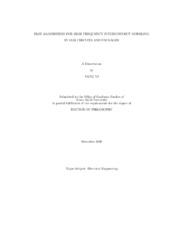| dc.description.abstract | Interconnect modeling plays an important role in design and verification of VLSI
circuits and packages. For low frequency circuits, great advances for parasitic resistance
and capacitance extraction have been achieved and wide varieties of techniques
are available. However, for high frequency circuits and packages, parasitic inductance
and impedance extraction still poses a tremendous challenge. Existing algorithms,
such as FastImp and FastHenry developed by MIT, are slow and inherently unable
to handle multiple dielectrics and magnetic materials.
In this research, we solve three problems in interconnect modeling for high frequency
circuits and packages.
1) Multiple dielectrics are common in integrated circuits and packages. We propose
the first Boundary Element Method (BEM) algorithm for impedance extraction
of interconnects with multiple dielectrics. The algorithm uses a novel equivalentcharge
formulation to model the extraction problem with significantly fewer unknowns.
Then fast matrix-vector multiplication and effective preconditioning techniques
are applied to speed up the solution of linear systems. Experimental results
show that the algorithm is significantly faster than existing methods with sufficient
accuracy.
2) Magnetic materials are widely used in MEMS, RFID and MRAM. We present the first BEM algorithm to extract interconnect inductance with magnetic materials.
The algorithm models magnetic characteristics by the Landau Lifshitz Gilbert equation
and fictitious magnetic charges. The algorithm is accelerated by approximating
magnetic charge effects and by modeling currents with solenoidal basis. The relative
error of the algorithm with respect to the commercial tool is below 3%, while the
speed is up to one magnitude faster.
3) Since traditional interconnect model includes mutual inductances between
pairs of segments, the resulting circuit matrix is very dense. This has been the main
bottleneck in the use of the interconnect model. Recently, K = L-1 is used. The
RKC model is sparse and stable. We study the practical issues of the RKC model.
We validate the RKC model and propose an efficient way to achieve high accuracy
extraction by circuit simulations of practical examples. | en |


